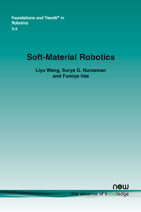Soft-Material Robotics
By Liyu Wang, University of California Berkeley, USA, liyu.wang@wadh.oxon.org | Surya G. Nurzaman, Monash University, Australia, surya.nurzaman@monash.edu | Fumiya Iida, University of Cambridge, UK, fi224@cam.ac.uk
Abstract
There has been a boost of research activities in robotics using soft materials in the past ten years. It is expected that the use and control of soft materials can help realize robotic systems that are safer, cheaper, and more adaptable than the level that the conventional rigid-material robots can achieve. Contrary to a number of existing review and position papers on soft-material robotics, which mostly present case studies and/or discuss trends and challenges, the review focuses on the fundamentals of the research field. First, it gives a definition of softmaterial robotics and introduces its history, which dates back to the late 1970s. Second, it provides characterization of soft-materials, actuators and sensing elements. Third, it presents two general approaches to mathematical modelling of kinematics of soft-material robots; that is, piecewise constant curvature approximation and variable curvature approach, as well as their related statics and dynamics. Fourth, it summarizes control methods that have been used for soft-material robots and other continuum robots in both model-based fashion and model-free fashion. Lastly, applications or potential usage of soft-material robots are described related to wearable robots, medical robots, grasping and manipulation.
Soft-Material Robotics
The last decade has witnessed an increasing interest in the more active use of soft materials in robotic systems. Having a soft body like the ones in biological systems can potentially provide a robot with superior capabilities. For example, soft body can help the robots to adaptively navigate through small openings, softness can prevent injuries in human-robot interaction, while deformable body can also store and release energy, which may lead to energy effciency in locomotion tasks. By building robotic systems with soft materials, we can realize systems that are safer, cheaper, and more adaptable than the level that conventional rigid-material robots can achieve.
Soft-Material Robotics introduces the fundamental aspects of this vibrant research topic from history, modelling, control, and system integration. This content sets it apart from previous review efforts that have focused on presenting individual case studies.
